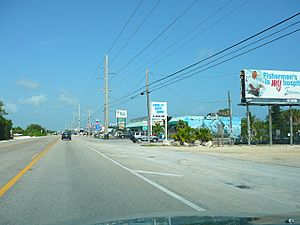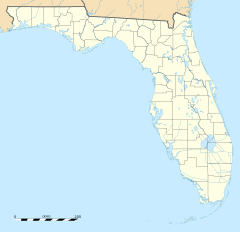Summerland Key facts for kids
Quick facts for kids
Summerland Key
|
|
|---|---|

The Overseas Highway as it goes through Summerland Key
|
|
| Country | |
| State | |
| County | Monroe |
| Elevation | 0 ft (0 m) |
| Time zone | UTC-5 (Eastern (EST)) |
| • Summer (DST) | UTC-4 (EDT) |
| ZIP code |
33042
|
| Area code(s) | 305 and 786 |
Summerland Key is a beautiful island in the lower Florida Keys. It is about 20 miles (32 km) east of Key West. This island is home to a community that is not officially a city or town, but part of Monroe County.
U.S. 1, also known as the Overseas Highway, runs right through the island. You can find it between mile markers 24 and 25.5, located between Ramrod Key and Cudjoe Key. The name "Summerland Key" first appeared on a map from the United States Coast Survey in 1878.
Contents
Life in Summerland Key
Summerland Key is a quiet place where many people live and then travel to work in nearby cities. It is located almost exactly halfway between the larger communities of Marathon and Key West.
The island is home to some interesting places. These include the Brinton Environmental Center, which is part of the Florida National High Adventure Sea Base. It is also a field station for the Mote Marine Laboratory, where scientists study ocean life.
There is even a private airstrip on the island, which is about 2,550 feet long. It is located just south of the Overseas Highway near mile marker 25. In the past, some people on Summerland Key also worked in commercial fishing.
The History of Summerland Key
The story of modern Summerland Key began in 1948 with a man named Henry Hudgins. He started to turn this wild, uninhabited island into a nice place for people to live.
Building a Community
Henry Hudgins was a chief engineer for the City of Miami. He met Waren Niles, whose family owned a large part of Summerland Key since the early 1900s. In 1941, the Niles family decided they might want to sell their land. By 1947, Hudgins offered $100,000 to buy the property, and the Niles family agreed.
In the fall of 1948, two hurricanes hit the Lower Keys. The ocean water rose about six feet, causing a lot of flooding. After seeing how high the water got, Hudgins decided that any homes built on Summerland Key would need to be raised up.
He bought two old military buildings and had his construction workers put them on top of tall utility poles. This was done at the spot where Dobie Street is today. This was the Hudgins family's first home on Summerland. It was also one of the very first homes in the Keys built on stilts. Today, building rules require all homes to be raised above the floodplain to protect them from floods.
Developing the Island
Hudgins made plans for new streets and canals on the island. He started digging the canals, but he wasn't happy with how it was going. So, he came up with a new way to dig canals. This new method was later used for digging all the man-made canals throughout the Florida Keys.
During the development of Summerland Key, the closest post office was on Ramrod Key, and it had been there since 1919. After many years of trying, Hudgins finally got a chance to have a post office on Summerland. When the postmaster in Ramrod Key retired, she suggested moving the post office to Summerland. Henry Hudgins was then named the new postmaster.
An Airstrip and Dream Home
Hudgins' wife, Mary, learned to fly an airplane and kept her plane in Marathon. She met Philip Toppino, who also loved flying. Toppino suggested that Hudgins build an airstrip on Summerland. Around 1956, Hudgins and Toppino worked together to develop a part of Summerland called Summerland Cove. This area had a landing strip with homes on both sides and canals behind them.
As more properties were sold, Hudgins moved his family to a small wooden house on Center Street. This put them closer to the post office. That house is still standing today.
In the late 1950s, Hudgins bought land to build his dream home, which he called Hermitage. This property faced Niles Channel and was once owned by the Garibaldi Niles family. Hudgins designed the home himself. It sat on strong concrete pillars and had a porch facing the channel. The house was built to withstand very strong winds, up to 150 miles per hour. Hermitage is still standing today. Sadly, Hudgins only got to enjoy his amazing home for a few years before he passed away in 1962.
Lasting Legacies
Henry Hudgins left many important things behind in Summerland Key. These include the airstrip off West Shore Drive, Henry Street (named after him), Dobie Street (named after his second wife), and Hermitage, his dream home on Niles Channel.
Summerland Key was also the home of famous singer-songwriter Fred Neil. He wrote well-known songs like "The Dolphins" and "Everybody's Talkin'." Fred Neil passed away on Summerland Key in July 2001.




